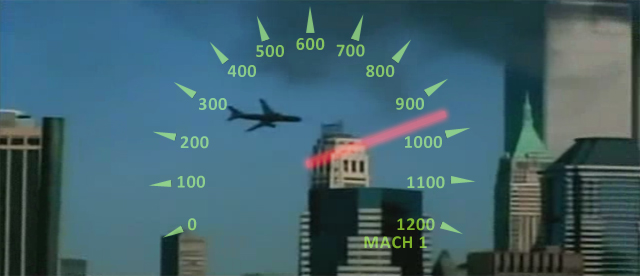Using 911facts.dk

How do you get the most out of this site?
Truth Movement
Publications
Booking

We are available for booking a lecture or a workshop here.

Flight 175 could not fly 950 km/h

Claim
A standard Boeing 767 cannot fly at a velocity of 950 km/h close to sea level without being torn apart.0Background
The claim is based on the assumption that Flight 175, a Boeing 767-222, was not designed to fly as fast as it did, when it hit the World Trade Center 2. Additionally, it was not possible to control the plane, so that it could hit the building. Thus, it cannot be Flight 175 that hit the World Trade Center 2.Facts
All available evidence points to Flight 175 hitting the World Trade Center 2. Some of the evidence is listed here:- United Airlines is missing a Boeing 767-2221.
- Passengers and crew are missing2.
- DNA from the passengers and crew were found on board3.
- Communication between Air Traffic Control and the plane points to a hijacking4.
- Radar shows the route of the plane5.
- Phone calls from passengers confirm the hijacking6.
- Thousands of witnesses saw the impact from the streets of New York City. Millions saw it live on television7.
- Debris from the plane was found in the streets and in the ruins8.

Examples of Boeing 757 and 767 planes flying very fast close to the ground without disintegrating:
757 Extreme Low Pass
Logic
The harsh truth is that the plane could actually fly as fast as it did. It may be unknown to most people, perhaps even Boeing’s own test pilots, that a passenger plane could be pressed as far as was the case, but video and data proves that it could be done at least in this case.Claiming that it had to be a modified plane that hit the World Trade Center 2 contradicts all videos of the disaster, since those show that, regardless of type, the physical design is the same, especially regarding wing proportions and placement on the hull. This means that Flight 175 would not be significantly different to maneuver than a modified plane resembling Flight 175 to such a degree that one could not tell the difference from photos.
On the other hand, it means that, had a conspiracy planned the attack using something that looks that much like Flight 175 as the images show, it would be incredibly stupid to increase the speed to 900-950 km/h, since it would become uncertain if the plane would be able to reach its intended target.
The claim is in conflict with another claim, namely that the World Trade Center 1 and 2 were built to withstand modern passenger planes. The latter claim presupposes that the planes that hit the Twin Towers were ordinary unmodified Boeing 767’s.
Conclusion
The claim is therefore:- Insufficiently documented
- Self-contradicting
- In conflict with another claim
Sources
- “En standard Boeing 767 KAN ikke flyve med 950 km/t tæt på sea level (1000 fod) uden at blive revet i stykker.”, Jeppe Severin, Facebook
- Hijacking description, Flight 175, Aviation Safety Network
- United Airlines Flight 175, victims, CNN
- More than half of victims IDd, New York Daily News
- Flight Path Study United Airlines 175, National Transportation Safety Board
- Radar Data Impact Speed Study United Airlines Flight 175, National Transportation Safety Board
- Moussaoui Jury Hears the Panic From 9/11, Los Angeles Times
- Nyhedsudsendelser, 11. september, 2001
- Billeder af Flight 175, vragdele
- NIST NCSTAR 1-2B Analysis of Aircraft Impacts into the World Trade Center Towers, side 67, NIST
- Emailkorrespondance med Pierre Viby, flyinstruktør og 767-pilot, Centerair, Roskilde
- Factor of safety, Wikipedia
- Retrospect: September 11, 2001: Attack on America, WeatherWise.org
Q & A

